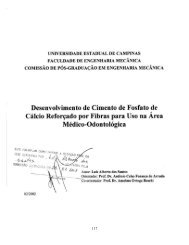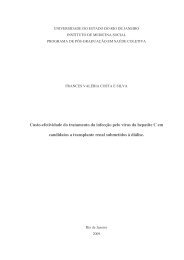SUS: avanços e desafios, 2006. - BVS Ministério da Saúde
SUS: avanços e desafios, 2006. - BVS Ministério da Saúde
SUS: avanços e desafios, 2006. - BVS Ministério da Saúde
Create successful ePaper yourself
Turn your PDF publications into a flip-book with our unique Google optimized e-Paper software.
164<br />
<strong>SUS</strong>: AVANÇOS E DESAFIOS<br />
in Latin America. Rev. Panamericana de Salud Pública. 2000;8:84-92.<br />
Arretche M. Financiamento federal e gestão local de políticas sociais: o difícil<br />
equilíbrio entre regulação, responsabili<strong>da</strong>de e autonomia. Mimeo; 2003.<br />
North D. Institutions, institutional changes and economic performance.<br />
Cambridge: Cambridge University Press; 1990.<br />
Marques E, Arretch M. Condicionantes locais <strong>da</strong> descentralização <strong>da</strong> política<br />
de saúde. XXVII Encontro Nacional <strong>da</strong> ANPOCS: mimeo; 2002.<br />
Mills A et al. Health system decentralization: concepts, issues and<br />
countries experiences. Geneva: World Health Organization; 1990.<br />
Organização Mundial <strong>da</strong> <strong>Saúde</strong>. Cui<strong>da</strong>dos inovadores para condições<br />
crônicas: componentes estruturais de ação. Brasília: Organização<br />
Mundial <strong>da</strong> <strong>Saúde</strong>; 2003.<br />
Hunter DJ, Vienonen M, Wlo<strong>da</strong>rczyc WC. Optimal balance of centralized<br />
and decentralized management. In: Saltman RB, Figueras J,<br />
Sakellarides C, editores. Critical challenges for health care reform in<br />
Europe. Buckingham: Open University Press; 1998.<br />
Holman H, Lorig K. Patients as partners in managing chronic disease.<br />
Br Med J. 2000;320:526-7.<br />
IBGE. Projeção <strong>da</strong> população do Brasil por sexo e i<strong>da</strong>de para o período<br />
1980-2050: revisão de 2004. Rio de Janeiro: IBGE; 2004.<br />
Hsiao W. What should macroeconomists know about health care: a<br />
primer. Washington: International Monetary Fund; 2000. IMF Working<br />
Paper WP/00/136.<br />
Barbosa J et al. Doenças e agravos não transmissíveis: bases epidemiológicas.<br />
In; Rouquayrol MZ, Almei<strong>da</strong> Filho N. Epidemiologia e saúde.<br />
6ª ed. Rio de Janeiro; 2003.<br />
Schramm JM et al. Transição epidemiológica e o estudo <strong>da</strong> carga de<br />
doença no Brasil. Ciênc saúde coletiva. 2004;9:897-908.<br />
<strong>Ministério</strong> <strong>da</strong> <strong>Saúde</strong>. A vigilância, o controle e a prevenção <strong>da</strong>s doenças<br />
crônicas não transmissíveis, DCNT no contexto do Sistema único<br />
de <strong>Saúde</strong>. Brasília: DASS, SVS, <strong>Ministério</strong> <strong>da</strong> <strong>Saúde</strong>; 2005c.<br />
Ezzati M et al. Selected major risk factors and global and regional burden<br />
of disease. Lancet. 2002;360:1347-60.<br />
Machado EM, Maia AC. A situação de saúde em Minas Gerais. Belo<br />
Horizonte: Fun<strong>da</strong>ção João Pinheiro; <strong>2006.</strong>

















